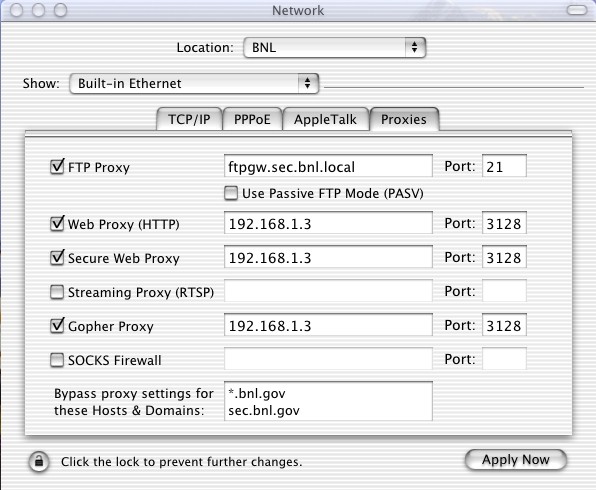Subnet Mask: 255.255.254.0
Router: 130.199.88.24
Domain Name Servers: 130.199.128.31
130.199.1.1
Search Domains: star.bnl.gov
rcf.bnl.gov
rhic.bnl.gov
bnl.gov
If one does not have a BNL IP address, then select the "Using DHCP"
configuration setting (one can still optionally include the search
domains listed above, but everything else is automatic with DHCP).
Under the Proxies tab, activate all proxy selections and enter 192.168.1.3,
port 3128 for the proxy. Future versions of OS X may allow the use of the
automated proxy script (http://security.bnl.gov/proxy/cfg.pag), but this
is not yet implemented and one must enter the actual proxy IP address.
In the "bypass proxy settings" area, enter
*.bnl.gov, sec.bnl.gov, 192,168.*, 130.199.*. Shown below
is the Proxies panel for the system network settings. Look
here for proxy settings
for some individual applications.

We have wireless networking in some STAR work areas if you have an AirPort card. For more information, see STAR Wireless Networking at BNL. The WEP key is what should be entered for the password (with a "$" in front).
After installing the package, there are a few things that must be done to work with RCF:
- As superuser, edit CellServDB (found in /var/db/openafs/etc for OpenAFS)
to add the following lines:
>rhic.bnl.gov #Relativistic Heavy Ion Collider 130.199.6.51 #rafs03.rcf.bnl.gov 130.199.6.52 #rafs02.rcf.bnl.gov 130.199.6.69 #rafs01.rcf.bnl.gov
Alternatively, one can copy this file from any rcas machine at /usr/vice/etc/CellServDB. - As superuser, edit ThisCell (found in /var/db/openafs/etc for OpenAFS)
to have only the following line:
rhic.bnl.gov
- Set your environment variable for the STAR software library.
You can do this in a .tcshrc or .cshrc file in your
home directory as you would in other unix variants, but then your
Applications (stuff you do not run from the command line) would not
see these variables. So it is actually best to edit your
~/.MacOSX/environment.plist file. This is a little more complicated
and is best done using something like
RCEnvironment
(I also recommend RCDefaultApp on that same website).
You can select the STAR
software library of your choice (replace 'pro' below with 'new' or 'dev'
if you like your default STAR environment to be anything other than 'pro'):
setenv STAR /afs/rhic/star/packages/pro
for tcsh. (If you're using a shell other than tcsh, then you probably know how to set environment variables in that shell. If you're not sure which shell you're using, type echo $shell to find out. And in the RCEnvironment preference pane, you simply add (+) an entry with STAR for the key and the appropriate value above.) Eventually I would like to be able to load the entire STAR environment variables, but for now this is dangerous because some of the STAR scripts change your path! - If you have CVS installed on your machine (type which cvs),
you can use it to check code in and out of the repository by placing the
following in the same environment file:
setenv CVSROOT /afs/rhic/star/packages/repository
There are also several choices of window managers with Xfree86/XDarwin. The twm manager comes included. Motif (mwm) is available as a free, and easily installed package called Lesstif (www.lesstif.org), as openMotif (openMotif.org) does not currently support OS X. But I recommend OroborOSX (if you are not already using Apple's X11 Aqua interface) (wrench.et.ic.ac.uk/adrian/software/oroborosx/), which imitates OS X (Aqua) style windows and provides window themes and some menu services. But if you decide to use Fink (fink.sourceforge.net) to install packages (and they have a LOT of packages for OS X!), there are over a dozen other window managers.
I opted to create a directory /opt/root as superuser for my ROOT installation. I had to do two things different than was stated in the instructions for ROOT: I use tcsh instead of bash, so I had to use setenv instead of export in my environment.mine file, and $DYLD_LIBRARY_PATH was not defined anyhwere else first, so I changed the redefinition of this variable. If I were using a .tcshrc file, it would look something like:
setenv ROOTSYS /opt/root/pro #setenv DYLD_LIBRARY_PATH $DYLD_LIBRARY_PATH\:$ROOTSYS/lib setenv DYLD_LIBRARY_PATH $ROOTSYS/lib setenv PATH $PATH\:$ROOTSYS/binUsing the environment plist file, I cannot use environment variables in the definition of an environment variable, so I have (replace the ellipses below with your own paths):
ROOTSYS /opt/root/dev DYLD_LIBRARY_PATH ...:/opt/root/dev/lib PATH ...:/opt/root/dev/bin
If anyone wants to try to compile root4star on their machine, they are welcome to. I have not tried this myself, so I'm not aware of what pieces of code specifically are required. Please let me know if you do and I can post the instructions here.
I also recommend aliasing ssh to 'ssh -X -A' to automate authentication and XWindow forwarding.
Here are some other tips/tricks for OSX I've found worthwhile:
- Good software sites:
- Window buffer compression hack (frees memory, better window performance)
- Swap space determination (frees hard disk space, better vm performance)
- Broadband Optimizer (increases download buffer sizes)